
 cloudy: stiff west wind: 24ºF
cloudy: stiff west wind: 24ºF
The last Saturday of the year. And the last of my garden walks in this botanical garden this year. I remember when I was a kid I enjoyed the last day of school before the holiday break because it was a chance for me to say to a friend, “See you next year.” We would both let out with silly hoots knowing that next year was just a few days away. But the words “next year” seemed to stretch time.
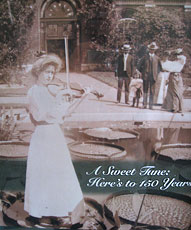
Yearend marks the end of this botanical garden’s 150th yearlong celebration. The most prominent marker of the garden’s sesquicentennial year was the floral clock that was put up in the spring and dismantled in the fall. The clock was twenty feet across and was filled with plants and flowers that changed with the seasons. Close by a chirping coo coo bluebird poked out of a birdhouse every fifteen minutes. Big and prominent as it was, I don’t think the floral clock ever drew much interest from the point-and-shoot camera crowd. Maybe if the face of the clock had been tilted up higher from the ground or if the barrier chain that stopped visitors from getting too close had been removed, the clock might have gotten more attention. A platform set in front of the clock where visitors could have posed to have their pictures would have helped too. A missed opportunity to let visitors take away their own mementos of the garden’s anniversary.
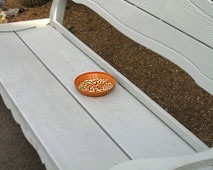
This time of year, birds and squirrels sometimes get trapped in the garden’s glasshouse. On sunny days, windows and doors are opened for ventilation and the creatures come in, but don’t leave in time to beat the closing. Perhaps to keep the unintended visitors healthy or maybe to keep them from damaging the plants inside, the keepers of the garden have set out plant saucers filled with millet, cracked corn, banana slices, and green peas.

As cold as it is and as cold as it has been for the last few weeks, I was surprised to find that a few early spring shrubs and trees had started blooming. In the Chinese Garden both the white and pink apricot trees are showing color. Near the boundary wall near the daylily garden, there’s a ‘Dawn’ viburnum that’s put out a few clusters of pink, fragrant blooms. It’s too early for any of these blooms to be out. They, and any others that may have had ideas of a staging a spring preview, will be gone when the sub-zero temperatures forecast for next week arrive.
There is another spot in the garden though where the keepers have managed to hold back the cold and wind. They’ve built a high brick wall on two sides – the north and the west. The brick wall screens out the worst of the winds and also catches and holds the winter sun. In the V-shaped space formed by the walls, the keepers have planted what they call “marginally hardy plants” -- plants that try to push back the garden’s 6a climate (winter lows of no more than -10º
F). Planted here is a clump of the very picky
‘Variegata’ hydrangeas (
Hygrangea macrophylla). I found that nurseries that guarantee their shrubs for a year don’t even stock the cold-risky ‘Variegata.’ But here in this sheltered cove it’s thriving.
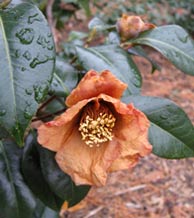
Hardy camellias are the featured attraction in this zone-busting garden. There are about a half dozen of them here – all with spring sounding or winter defying names. This one is a
Camellia japonica named ‘Spring’s Promise.’ For regular
japonicas, “hardy” means winter temperatures that never dip much below 20ºF. The
hardy varieties of the japonicas though are supposed to make it though lows of zero even a bit below. Most of the hardy varieties that the keepers have planted in unsheltered locations already look battered. But, here in this protected space, “Spring’s Promise’ looks pretty good. Its early blooms look frost bitten, but its buds seem healthy and its leaves are still deep green and glossy.
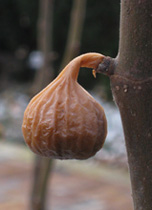
Here’s a fig growing outdoors. It’s still clinging to its stock. How much more winter can it can take?

 cloudy: breezy: 33ºF
cloudy: breezy: 33ºF
 The ground is still crackly from a couple of weeks of cold. Much of this botanical garden still needs to be cleaned, planted, and put to bed for the winter. The large perennial beds are still covered with the decaying, leafy remains of summer and a good number of spring-flowering bulbs have yet to be planted. I know that even though the close-out sales of tulips have ended at the nurseries around here, that bulbs can still be planted in mid-winter as long as the ground isn’t frozen. Could be that a delayed planting means later blooming in the spring. If so, that would mean come spring, that the late comers will begin to kick-in just as the October-planted blooms start to peter out. Whatever the case, it’s about time that even the late bulbs get nestled all snug in their beds.
The ground is still crackly from a couple of weeks of cold. Much of this botanical garden still needs to be cleaned, planted, and put to bed for the winter. The large perennial beds are still covered with the decaying, leafy remains of summer and a good number of spring-flowering bulbs have yet to be planted. I know that even though the close-out sales of tulips have ended at the nurseries around here, that bulbs can still be planted in mid-winter as long as the ground isn’t frozen. Could be that a delayed planting means later blooming in the spring. If so, that would mean come spring, that the late comers will begin to kick-in just as the October-planted blooms start to peter out. Whatever the case, it’s about time that even the late bulbs get nestled all snug in their beds.
I left the main walkway to take a closer look at large shrub just because I liked its name – Christmas Berry (Photinia villosa). The multi-stemmed shrub was completely bare. No leaves and not a sign of berries. My National Garden Book says that Christmas Berry is supposed to have elderberry-like clusters of bright red berries dangling from the ends of its stems right about now. But then it goes on to say, “Attractive to birds.” How did the shrub ever get the name Christmas Berry, I wonder? Somewhere there must be a magical land where birds patiently wait until after Christmas to have their feast of berries. Wherever that may be, it’s not Mid-West, U.S.A.
 A witch hazel named ‘Christmas Cheer’ does deliver on its promise though. ‘Christmas Cheer’ is an unusually early-blooming variety of the Ozark witch hazel (Hamamelis vernalis). Around here the regular Ozark witch hazels don’t flower until late January at best. ‘Christmas Cheer’s’ burnished red flowers lack the vivid canary-yellow hues of most witchhazels and the blooms aren’t nearly as large as the new hybrid varieties. But unlike those others, ‘Christmas Cheer’ is flowering right here, right now. And the competition isn’t.
A witch hazel named ‘Christmas Cheer’ does deliver on its promise though. ‘Christmas Cheer’ is an unusually early-blooming variety of the Ozark witch hazel (Hamamelis vernalis). Around here the regular Ozark witch hazels don’t flower until late January at best. ‘Christmas Cheer’s’ burnished red flowers lack the vivid canary-yellow hues of most witchhazels and the blooms aren’t nearly as large as the new hybrid varieties. But unlike those others, ‘Christmas Cheer’ is flowering right here, right now. And the competition isn’t.
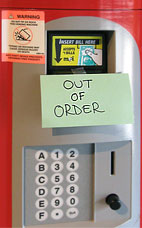 The exhibit featuring energy-saving ideas and products that was scheduled to end in October has been held over until spring. This morning I read a sign near the vending machines that read “Things can go better with solar Coke.” The sign said that the vending machine on the left is being powered by solar panels on the roof. The one on the right runs on standard fossil-fueled electricity. The sign then goes on to say, “You can vote for solar with your refreshment dollars. Which machine will you choose?” I took this picture of the machine on the left.
The exhibit featuring energy-saving ideas and products that was scheduled to end in October has been held over until spring. This morning I read a sign near the vending machines that read “Things can go better with solar Coke.” The sign said that the vending machine on the left is being powered by solar panels on the roof. The one on the right runs on standard fossil-fueled electricity. The sign then goes on to say, “You can vote for solar with your refreshment dollars. Which machine will you choose?” I took this picture of the machine on the left.
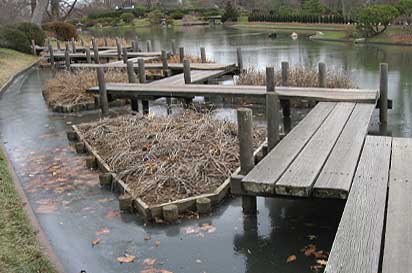
I walked over this zig-zag bridge in the Japanese Garden this morning. At each turn of the bridge is a bed of Japanese irises. Last week I saw a 19th Century Japanese screen at the art museum called ‘Irises and Eight-Fold Bridge’ that looks much
 like the bridge here. The bridge and irises on the screen are meant to be reminders of a tender love poem that uses a syllable of the Japanese word for iris to begin each line. I bought this postcard that shows a slice of the screen painting being exhibited at the museum. It helps to remind me of what I hope to see here in this Japanese Garden when June comes again.
like the bridge here. The bridge and irises on the screen are meant to be reminders of a tender love poem that uses a syllable of the Japanese word for iris to begin each line. I bought this postcard that shows a slice of the screen painting being exhibited at the museum. It helps to remind me of what I hope to see here in this Japanese Garden when June comes again.

 clear: calm: 23ºF
clear: calm: 23ºF
 At last. Temperatures in the low 20s have ended it all. I wanted to get to the botanical garden early this morning to catch the plants and flowers before they’re fully aware of what’s just happened to them. The roses still have their color and most of their shape. It’s just that they look as though they’ve been flash frozen. This is ‘Carefree Spirit,’ the same award-winning shrub rose that I took a picture of last week.
At last. Temperatures in the low 20s have ended it all. I wanted to get to the botanical garden early this morning to catch the plants and flowers before they’re fully aware of what’s just happened to them. The roses still have their color and most of their shape. It’s just that they look as though they’ve been flash frozen. This is ‘Carefree Spirit,’ the same award-winning shrub rose that I took a picture of last week.
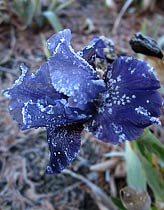 After taking one picture of a bloom that will turn to mush when the frost no longer supports its petals, I started to look for more frozen flowers. Here’s a blue reblooming iris that still has all of its struts in place. It’s another short-lived phenomenon that will be gone when the sun gets higher and the temperature rises.
After taking one picture of a bloom that will turn to mush when the frost no longer supports its petals, I started to look for more frozen flowers. Here’s a blue reblooming iris that still has all of its struts in place. It’s another short-lived phenomenon that will be gone when the sun gets higher and the temperature rises.
 I liked this one too. Four hydrangea stems, drooping and darkened by the cold. I’ve walked by them dozens of times without noticing them. This morning though they stand out. Contrast maybe – the dark foliage against the light gray of the stone wall. The stocks could be characters in a Dickens novel – ragged, downtrodden, and maybe looking for a handout from anyone who passes the wall.
I liked this one too. Four hydrangea stems, drooping and darkened by the cold. I’ve walked by them dozens of times without noticing them. This morning though they stand out. Contrast maybe – the dark foliage against the light gray of the stone wall. The stocks could be characters in a Dickens novel – ragged, downtrodden, and maybe looking for a handout from anyone who passes the wall.

Finally, the boxwoods -- so many of them in this botanical garden. The combination of calm winds, high humidity, and cold temperatures put a white fringe around each of the tiny leaves.
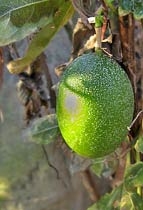 In the area of the botanical garden set aside for native flowers and plants, I found this passion fruit hanging from a wilted vine. The fruit was about the size of a lemon and the color of a lime. I’ve seen passion flowers (Passifloria Incarnata) before, but never the fruit. According my latest edition of Edgar Dennison’s Missouri Wild Flowers the fruit is supposed to turn yellow when ripe and to have a “sweet pulp similar to citrus.” Dennison also says without explanation that the fruits are sometimes called Maypops. Other sources explain that passion fruits got that name because the air space inside the fruit pops much like the bubbles on plastic packing sheets when the fruit is squashed. I don’t know whether the green fruits I saw this morning will turn yellow or whether they just didn’t get enough time to fully ripen. I’ll come back next week to find out how they doing.
In the area of the botanical garden set aside for native flowers and plants, I found this passion fruit hanging from a wilted vine. The fruit was about the size of a lemon and the color of a lime. I’ve seen passion flowers (Passifloria Incarnata) before, but never the fruit. According my latest edition of Edgar Dennison’s Missouri Wild Flowers the fruit is supposed to turn yellow when ripe and to have a “sweet pulp similar to citrus.” Dennison also says without explanation that the fruits are sometimes called Maypops. Other sources explain that passion fruits got that name because the air space inside the fruit pops much like the bubbles on plastic packing sheets when the fruit is squashed. I don’t know whether the green fruits I saw this morning will turn yellow or whether they just didn’t get enough time to fully ripen. I’ll come back next week to find out how they doing.
For last few weeks flocks of migrating robins have been passing though the garden to refuel. Crabapples, hollies, and winterberries have been high on their list. A row of winterberries that was laden with red berries a few weeks ago has been completely stripped. This morning the flocks are gone. So are the berries. Slim winter pickings for local residents I’m afraid.
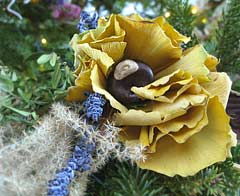 Each year some of the volunteers who work at the botanical garden decorate a tall pine tree in the garden center with ornaments they make of natural materials. Mostly they use gourds that they then cut or paint, but sometimes they use common natural things in unexpectedly beautiful ways. Here’s what could be a camellia flower or a magnolia bloom with petals made of yellow ginkgo leaves and a buckeye in the center.
Each year some of the volunteers who work at the botanical garden decorate a tall pine tree in the garden center with ornaments they make of natural materials. Mostly they use gourds that they then cut or paint, but sometimes they use common natural things in unexpectedly beautiful ways. Here’s what could be a camellia flower or a magnolia bloom with petals made of yellow ginkgo leaves and a buckeye in the center.

 inside exhibition hall
inside exhibition hall
I’ve lost track of when this botanical garden’s annual Christmas show morphed into a train show called “Gardenland Express.” Train shows that open just after Thanksgiving and run through New Year's Day have become a staple of the holiday fare offered at many botanical gardens. They all feature model trains that snake their way through some annually changing thematic landscape. Plants and flowers act as buffers to separate visitors from coming close enough to touch or possibly derail the trains. The recipe is simple, the result is delightful. I always see the train show at his botanical garden three or four times. For me it’s neither the flowers nor the trains that keep me coming back. It’s the people, especially the kids, watching the trains. Families come in droves pushing strollers from one train display pointing exuberantly and trying to edge in ever closer to the trains. I’m always amazed at the power trains have to pull the sense of wonder from all of us. Seeing it in others helps renew it in me.
 But to get back to the plants and flowers. While they are fillers, they are nonetheless carefully chosen fillers. Each year, the planners of this holiday show select some intriguing poinsettias to showcase and raft of other plants and flowers to display. In the handout detailing the cast of characters appearing in this year's show, there are over 100 plants and flowers listed including 17 different varieties of poinsettias. This year a poinsettia named ‘Orange Spice’ is center stage. The planners have placed dozens of them around the focal display in the center of the hall. Not surprising. The color orange is currently in vogue.
But to get back to the plants and flowers. While they are fillers, they are nonetheless carefully chosen fillers. Each year, the planners of this holiday show select some intriguing poinsettias to showcase and raft of other plants and flowers to display. In the handout detailing the cast of characters appearing in this year's show, there are over 100 plants and flowers listed including 17 different varieties of poinsettias. This year a poinsettia named ‘Orange Spice’ is center stage. The planners have placed dozens of them around the focal display in the center of the hall. Not surprising. The color orange is currently in vogue.
I looked at the sets and graphics used in television news shows, and orange, sometimes with its compliment blue, was always there. A website that tracks colors used in television news programs says that orange is a favorite because it “has an energetic feel, but can be a bit more approachable since it isn’t quite as harsh of a tone [as red]” Without mincing words another media consultant firm boldly says of orange: “The most flamboyant color on the planet! It's the color tied most to fun times, happy and energetic days, warmth and organic products. It is also associated with ambition. There is nothing even remotely calm associated with this color. Orange is associated with a new dawn in attitude.”
So ‘Orange Spice’ ought to be riding a trend right now. Yet, watchers of Christmas poinsettia sales aren’t so sure. Orange and Christmas don’t quite mesh they point out, but because orange does go well with Thanksgiving. So some large garden centers have started marketing them as “Thanksgiving Poinsettias.” Get an ‘Orange Spice’ for Thanksgiving and then replace it with a more traditional red for Christmas is the sales message. Ecke Ranch, the breeders of ‘Orange Spice,’ says it could be even be grown in time for Halloween – which if it catches on would be a brand-new market for poinsettias.
 At the holiday show, ‘Orange Spice’ is being displayed with a begonia named ‘Orange Brigitte.’ When it comes to being orange, ‘Orange Brigitte’ makes ‘Orange Spice’ looks like an orange wannabe. This begonia is so saturated with color that I had to turn down the light level on my camera to hold on to the highlights.
At the holiday show, ‘Orange Spice’ is being displayed with a begonia named ‘Orange Brigitte.’ When it comes to being orange, ‘Orange Brigitte’ makes ‘Orange Spice’ looks like an orange wannabe. This begonia is so saturated with color that I had to turn down the light level on my camera to hold on to the highlights.

There’s one more flower with orange in its name here too – a gloxinia name ‘Orange Bugle.’ I can’t help it. I see the word gloxinia and I think of those fleshy leaved plants with bell- shaped flowers, usually solid purple with a skirting of white around their flair, that my mother used to grow on top of her cedar chest. ‘Orange Bugles’ could not be more unlike that. This gloxinia has black-green slender lance-like leaves with tubular red-orange flowers that dangle up and over the foliage. This picture shows all three of the orange-named flowers together with a train engine just coming into view.
 If all the poinsettias at this show were for sale and I could buy just one, it would be this one. Marketers haven’t given it a catchy name yet, so for the time being it’s stuck with its breeder’s beta name: ‘HC-18B.’ The bracts are pastel pink with a hint of white along the veins and the margins. Aside from color though, what I find most appealing about ‘HC-18B’ is its bracts. They start small near their center and then get larger as they fan out. The effect is a layered look that makes each bloom look as though it’s a flower within a flower. I’m betting by next year ‘HC-18B’ will get a real name.
If all the poinsettias at this show were for sale and I could buy just one, it would be this one. Marketers haven’t given it a catchy name yet, so for the time being it’s stuck with its breeder’s beta name: ‘HC-18B.’ The bracts are pastel pink with a hint of white along the veins and the margins. Aside from color though, what I find most appealing about ‘HC-18B’ is its bracts. They start small near their center and then get larger as they fan out. The effect is a layered look that makes each bloom look as though it’s a flower within a flower. I’m betting by next year ‘HC-18B’ will get a real name.
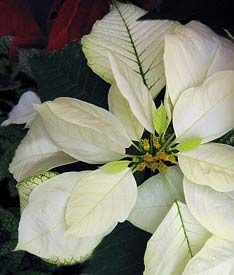 The newest poinsettia at this show is one named ‘Polar Bear.’ It has large off-white bracts edged with a few outer bracts that have traceries of green veins showing through. The Paul Ecke Ranch, the breeder of ‘Polar Bear,’ donates a bit of the proceeds of the cuttings it sells to the growers to Polar Bears International, an organization dedicated to preserving polar bears and their habitats. The biggest display of Polar Bear’ poinsettias in the country opened this week in (where else?) Las Vegas. The atrium of the Palazzo features a 16-foot tall polar bear and her 6-foot tall cub sitting on a make-believe ice float that’s suspended over a pool. Once every hour a shower of real snow falls over the scene. Except for the faces and claws of the bears, the rest of their bodies are covered with sphagnum moss into which about 10,000 ‘Polar Bear’ poinsettias have been planted -- two giant polar bear topiaries.
The newest poinsettia at this show is one named ‘Polar Bear.’ It has large off-white bracts edged with a few outer bracts that have traceries of green veins showing through. The Paul Ecke Ranch, the breeder of ‘Polar Bear,’ donates a bit of the proceeds of the cuttings it sells to the growers to Polar Bears International, an organization dedicated to preserving polar bears and their habitats. The biggest display of Polar Bear’ poinsettias in the country opened this week in (where else?) Las Vegas. The atrium of the Palazzo features a 16-foot tall polar bear and her 6-foot tall cub sitting on a make-believe ice float that’s suspended over a pool. Once every hour a shower of real snow falls over the scene. Except for the faces and claws of the bears, the rest of their bodies are covered with sphagnum moss into which about 10,000 ‘Polar Bear’ poinsettias have been planted -- two giant polar bear topiaries.

 Yearend marks the end of this botanical garden’s 150th yearlong celebration. The most prominent marker of the garden’s sesquicentennial year was the floral clock that was put up in the spring and dismantled in the fall. The clock was twenty feet across and was filled with plants and flowers that changed with the seasons. Close by a chirping coo coo bluebird poked out of a birdhouse every fifteen minutes. Big and prominent as it was, I don’t think the floral clock ever drew much interest from the point-and-shoot camera crowd. Maybe if the face of the clock had been tilted up higher from the ground or if the barrier chain that stopped visitors from getting too close had been removed, the clock might have gotten more attention. A platform set in front of the clock where visitors could have posed to have their pictures would have helped too. A missed opportunity to let visitors take away their own mementos of the garden’s anniversary.
Yearend marks the end of this botanical garden’s 150th yearlong celebration. The most prominent marker of the garden’s sesquicentennial year was the floral clock that was put up in the spring and dismantled in the fall. The clock was twenty feet across and was filled with plants and flowers that changed with the seasons. Close by a chirping coo coo bluebird poked out of a birdhouse every fifteen minutes. Big and prominent as it was, I don’t think the floral clock ever drew much interest from the point-and-shoot camera crowd. Maybe if the face of the clock had been tilted up higher from the ground or if the barrier chain that stopped visitors from getting too close had been removed, the clock might have gotten more attention. A platform set in front of the clock where visitors could have posed to have their pictures would have helped too. A missed opportunity to let visitors take away their own mementos of the garden’s anniversary. This time of year, birds and squirrels sometimes get trapped in the garden’s glasshouse. On sunny days, windows and doors are opened for ventilation and the creatures come in, but don’t leave in time to beat the closing. Perhaps to keep the unintended visitors healthy or maybe to keep them from damaging the plants inside, the keepers of the garden have set out plant saucers filled with millet, cracked corn, banana slices, and green peas.
This time of year, birds and squirrels sometimes get trapped in the garden’s glasshouse. On sunny days, windows and doors are opened for ventilation and the creatures come in, but don’t leave in time to beat the closing. Perhaps to keep the unintended visitors healthy or maybe to keep them from damaging the plants inside, the keepers of the garden have set out plant saucers filled with millet, cracked corn, banana slices, and green peas. As cold as it is and as cold as it has been for the last few weeks, I was surprised to find that a few early spring shrubs and trees had started blooming. In the Chinese Garden both the white and pink apricot trees are showing color. Near the boundary wall near the daylily garden, there’s a ‘Dawn’ viburnum that’s put out a few clusters of pink, fragrant blooms. It’s too early for any of these blooms to be out. They, and any others that may have had ideas of a staging a spring preview, will be gone when the sub-zero temperatures forecast for next week arrive.
As cold as it is and as cold as it has been for the last few weeks, I was surprised to find that a few early spring shrubs and trees had started blooming. In the Chinese Garden both the white and pink apricot trees are showing color. Near the boundary wall near the daylily garden, there’s a ‘Dawn’ viburnum that’s put out a few clusters of pink, fragrant blooms. It’s too early for any of these blooms to be out. They, and any others that may have had ideas of a staging a spring preview, will be gone when the sub-zero temperatures forecast for next week arrive. Hardy camellias are the featured attraction in this zone-busting garden. There are about a half dozen of them here – all with spring sounding or winter defying names. This one is a Camellia japonica named ‘Spring’s Promise.’ For regular japonicas, “hardy” means winter temperatures that never dip much below 20ºF. The hardy varieties of the japonicas though are supposed to make it though lows of zero even a bit below. Most of the hardy varieties that the keepers have planted in unsheltered locations already look battered. But, here in this protected space, “Spring’s Promise’ looks pretty good. Its early blooms look frost bitten, but its buds seem healthy and its leaves are still deep green and glossy.
Hardy camellias are the featured attraction in this zone-busting garden. There are about a half dozen of them here – all with spring sounding or winter defying names. This one is a Camellia japonica named ‘Spring’s Promise.’ For regular japonicas, “hardy” means winter temperatures that never dip much below 20ºF. The hardy varieties of the japonicas though are supposed to make it though lows of zero even a bit below. Most of the hardy varieties that the keepers have planted in unsheltered locations already look battered. But, here in this protected space, “Spring’s Promise’ looks pretty good. Its early blooms look frost bitten, but its buds seem healthy and its leaves are still deep green and glossy. Here’s a fig growing outdoors. It’s still clinging to its stock. How much more winter can it can take?
Here’s a fig growing outdoors. It’s still clinging to its stock. How much more winter can it can take? The ground is still crackly from a couple of weeks of cold. Much of this botanical garden still needs to be cleaned, planted, and put to bed for the winter. The large perennial beds are still covered with the decaying, leafy remains of summer and a good number of spring-flowering bulbs have yet to be planted. I know that even though the close-out sales of tulips have ended at the nurseries around here, that bulbs can still be planted in mid-winter as long as the ground isn’t frozen. Could be that a delayed planting means later blooming in the spring. If so, that would mean come spring, that the late comers will begin to kick-in just as the October-planted blooms start to peter out. Whatever the case, it’s about time that even the late bulbs get nestled all snug in their beds.
The ground is still crackly from a couple of weeks of cold. Much of this botanical garden still needs to be cleaned, planted, and put to bed for the winter. The large perennial beds are still covered with the decaying, leafy remains of summer and a good number of spring-flowering bulbs have yet to be planted. I know that even though the close-out sales of tulips have ended at the nurseries around here, that bulbs can still be planted in mid-winter as long as the ground isn’t frozen. Could be that a delayed planting means later blooming in the spring. If so, that would mean come spring, that the late comers will begin to kick-in just as the October-planted blooms start to peter out. Whatever the case, it’s about time that even the late bulbs get nestled all snug in their beds. A witch hazel named ‘Christmas Cheer’ does deliver on its promise though. ‘Christmas Cheer’ is an unusually early-blooming variety of the Ozark witch hazel (Hamamelis vernalis). Around here the regular Ozark witch hazels don’t flower until late January at best. ‘Christmas Cheer’s’ burnished red flowers lack the vivid canary-yellow hues of most witchhazels and the blooms aren’t nearly as large as the new hybrid varieties. But unlike those others, ‘Christmas Cheer’ is flowering right here, right now. And the competition isn’t.
A witch hazel named ‘Christmas Cheer’ does deliver on its promise though. ‘Christmas Cheer’ is an unusually early-blooming variety of the Ozark witch hazel (Hamamelis vernalis). Around here the regular Ozark witch hazels don’t flower until late January at best. ‘Christmas Cheer’s’ burnished red flowers lack the vivid canary-yellow hues of most witchhazels and the blooms aren’t nearly as large as the new hybrid varieties. But unlike those others, ‘Christmas Cheer’ is flowering right here, right now. And the competition isn’t. The exhibit featuring energy-saving ideas and products that was scheduled to end in October has been held over until spring. This morning I read a sign near the vending machines that read “Things can go better with solar Coke.” The sign said that the vending machine on the left is being powered by solar panels on the roof. The one on the right runs on standard fossil-fueled electricity. The sign then goes on to say, “You can vote for solar with your refreshment dollars. Which machine will you choose?” I took this picture of the machine on the left.
The exhibit featuring energy-saving ideas and products that was scheduled to end in October has been held over until spring. This morning I read a sign near the vending machines that read “Things can go better with solar Coke.” The sign said that the vending machine on the left is being powered by solar panels on the roof. The one on the right runs on standard fossil-fueled electricity. The sign then goes on to say, “You can vote for solar with your refreshment dollars. Which machine will you choose?” I took this picture of the machine on the left.
 like the bridge here. The bridge and irises on the screen are meant to be reminders of a tender love poem that uses a syllable of the Japanese word for iris to begin each line. I bought this postcard that shows a slice of the screen painting being exhibited at the museum. It helps to remind me of what I hope to see here in this Japanese Garden when June comes again.
like the bridge here. The bridge and irises on the screen are meant to be reminders of a tender love poem that uses a syllable of the Japanese word for iris to begin each line. I bought this postcard that shows a slice of the screen painting being exhibited at the museum. It helps to remind me of what I hope to see here in this Japanese Garden when June comes again. At last. Temperatures in the low 20s have ended it all. I wanted to get to the botanical garden early this morning to catch the plants and flowers before they’re fully aware of what’s just happened to them. The roses still have their color and most of their shape. It’s just that they look as though they’ve been flash frozen. This is ‘Carefree Spirit,’ the same award-winning shrub rose that I took a picture of last week.
At last. Temperatures in the low 20s have ended it all. I wanted to get to the botanical garden early this morning to catch the plants and flowers before they’re fully aware of what’s just happened to them. The roses still have their color and most of their shape. It’s just that they look as though they’ve been flash frozen. This is ‘Carefree Spirit,’ the same award-winning shrub rose that I took a picture of last week. After taking one picture of a bloom that will turn to mush when the frost no longer supports its petals, I started to look for more frozen flowers. Here’s a blue reblooming iris that still has all of its struts in place. It’s another short-lived phenomenon that will be gone when the sun gets higher and the temperature rises.
After taking one picture of a bloom that will turn to mush when the frost no longer supports its petals, I started to look for more frozen flowers. Here’s a blue reblooming iris that still has all of its struts in place. It’s another short-lived phenomenon that will be gone when the sun gets higher and the temperature rises. I liked this one too. Four hydrangea stems, drooping and darkened by the cold. I’ve walked by them dozens of times without noticing them. This morning though they stand out. Contrast maybe – the dark foliage against the light gray of the stone wall. The stocks could be characters in a Dickens novel – ragged, downtrodden, and maybe looking for a handout from anyone who passes the wall.
I liked this one too. Four hydrangea stems, drooping and darkened by the cold. I’ve walked by them dozens of times without noticing them. This morning though they stand out. Contrast maybe – the dark foliage against the light gray of the stone wall. The stocks could be characters in a Dickens novel – ragged, downtrodden, and maybe looking for a handout from anyone who passes the wall.
 In the area of the botanical garden set aside for native flowers and plants, I found this passion fruit hanging from a wilted vine. The fruit was about the size of a lemon and the color of a lime. I’ve seen passion flowers (Passifloria Incarnata) before, but never the fruit. According my latest edition of
In the area of the botanical garden set aside for native flowers and plants, I found this passion fruit hanging from a wilted vine. The fruit was about the size of a lemon and the color of a lime. I’ve seen passion flowers (Passifloria Incarnata) before, but never the fruit. According my latest edition of  Each year some of the volunteers who work at the botanical garden decorate a tall pine tree in the garden center with ornaments they make of natural materials. Mostly they use gourds that they then cut or paint, but sometimes they use common natural things in unexpectedly beautiful ways. Here’s what could be a camellia flower or a magnolia bloom with petals made of yellow ginkgo leaves and a buckeye in the center.
Each year some of the volunteers who work at the botanical garden decorate a tall pine tree in the garden center with ornaments they make of natural materials. Mostly they use gourds that they then cut or paint, but sometimes they use common natural things in unexpectedly beautiful ways. Here’s what could be a camellia flower or a magnolia bloom with petals made of yellow ginkgo leaves and a buckeye in the center. But to get back to the plants and flowers. While they are fillers, they are nonetheless carefully chosen fillers. Each year, the planners of this holiday show select some intriguing poinsettias to showcase and raft of other plants and flowers to display. In the handout detailing the cast of characters appearing in this year's show, there are over 100 plants and flowers listed including 17 different varieties of poinsettias. This year a poinsettia named ‘Orange Spice’ is center stage. The planners have placed dozens of them around the focal display in the center of the hall. Not surprising. The color orange is currently in vogue.
But to get back to the plants and flowers. While they are fillers, they are nonetheless carefully chosen fillers. Each year, the planners of this holiday show select some intriguing poinsettias to showcase and raft of other plants and flowers to display. In the handout detailing the cast of characters appearing in this year's show, there are over 100 plants and flowers listed including 17 different varieties of poinsettias. This year a poinsettia named ‘Orange Spice’ is center stage. The planners have placed dozens of them around the focal display in the center of the hall. Not surprising. The color orange is currently in vogue. At the holiday show, ‘Orange Spice’ is being displayed with a begonia named ‘Orange Brigitte.’ When it comes to being orange, ‘Orange Brigitte’ makes ‘Orange Spice’ looks like an orange wannabe. This begonia is so saturated with color that I had to turn down the light level on my camera to hold on to the highlights.
At the holiday show, ‘Orange Spice’ is being displayed with a begonia named ‘Orange Brigitte.’ When it comes to being orange, ‘Orange Brigitte’ makes ‘Orange Spice’ looks like an orange wannabe. This begonia is so saturated with color that I had to turn down the light level on my camera to hold on to the highlights.
 If all the poinsettias at this show were for sale and I could buy just one, it would be this one. Marketers haven’t given it a catchy name yet, so for the time being it’s stuck with its breeder’s beta name: ‘HC-18B.’ The bracts are pastel pink with a hint of white along the veins and the margins. Aside from color though, what I find most appealing about ‘HC-18B’ is its bracts. They start small near their center and then get larger as they fan out. The effect is a layered look that makes each bloom look as though it’s a flower within a flower. I’m betting by next year ‘HC-18B’ will get a real name.
If all the poinsettias at this show were for sale and I could buy just one, it would be this one. Marketers haven’t given it a catchy name yet, so for the time being it’s stuck with its breeder’s beta name: ‘HC-18B.’ The bracts are pastel pink with a hint of white along the veins and the margins. Aside from color though, what I find most appealing about ‘HC-18B’ is its bracts. They start small near their center and then get larger as they fan out. The effect is a layered look that makes each bloom look as though it’s a flower within a flower. I’m betting by next year ‘HC-18B’ will get a real name. The newest poinsettia at this show is one named ‘Polar Bear.’ It has large off-white bracts edged with a few outer bracts that have traceries of green veins showing through. The
The newest poinsettia at this show is one named ‘Polar Bear.’ It has large off-white bracts edged with a few outer bracts that have traceries of green veins showing through. The